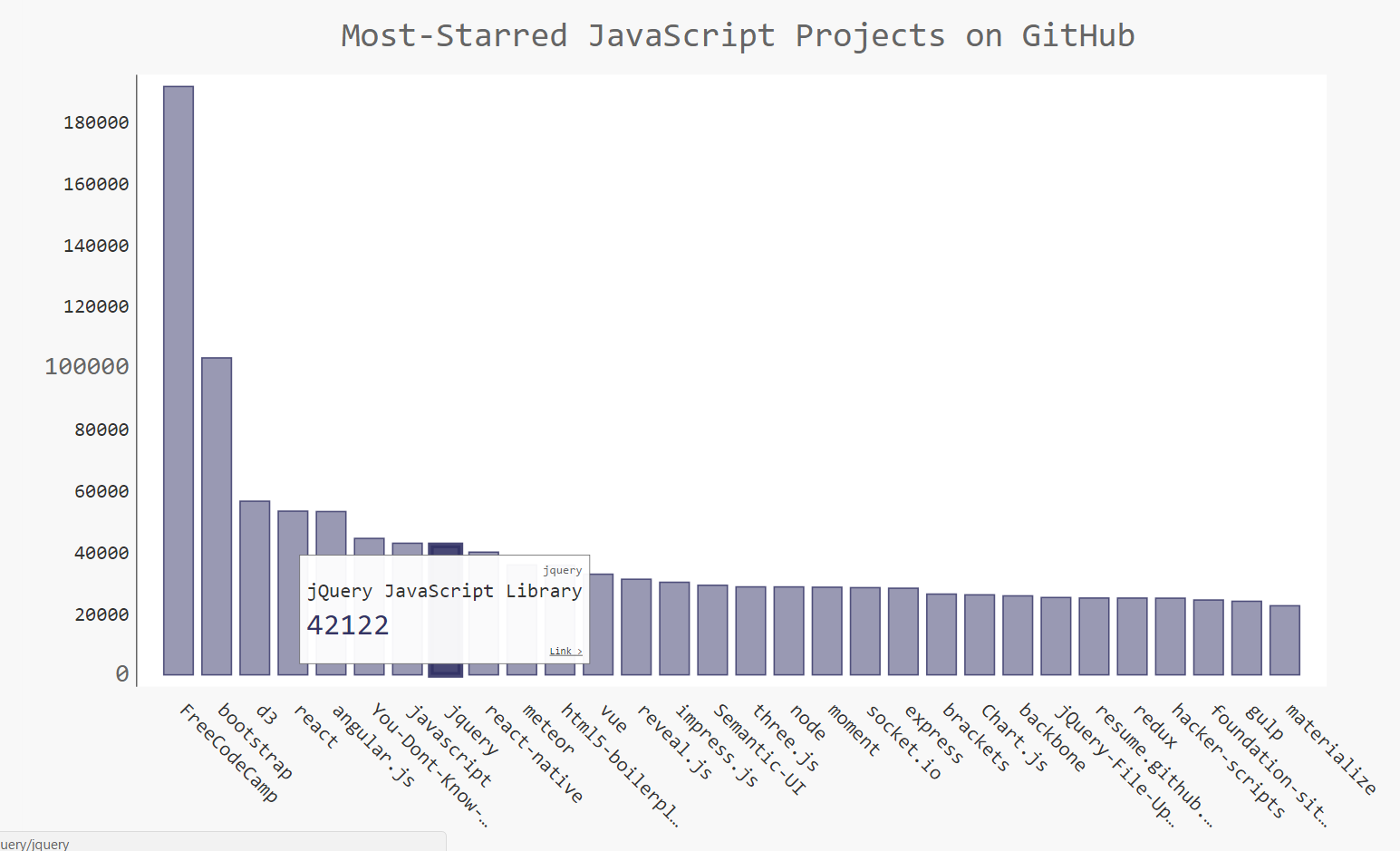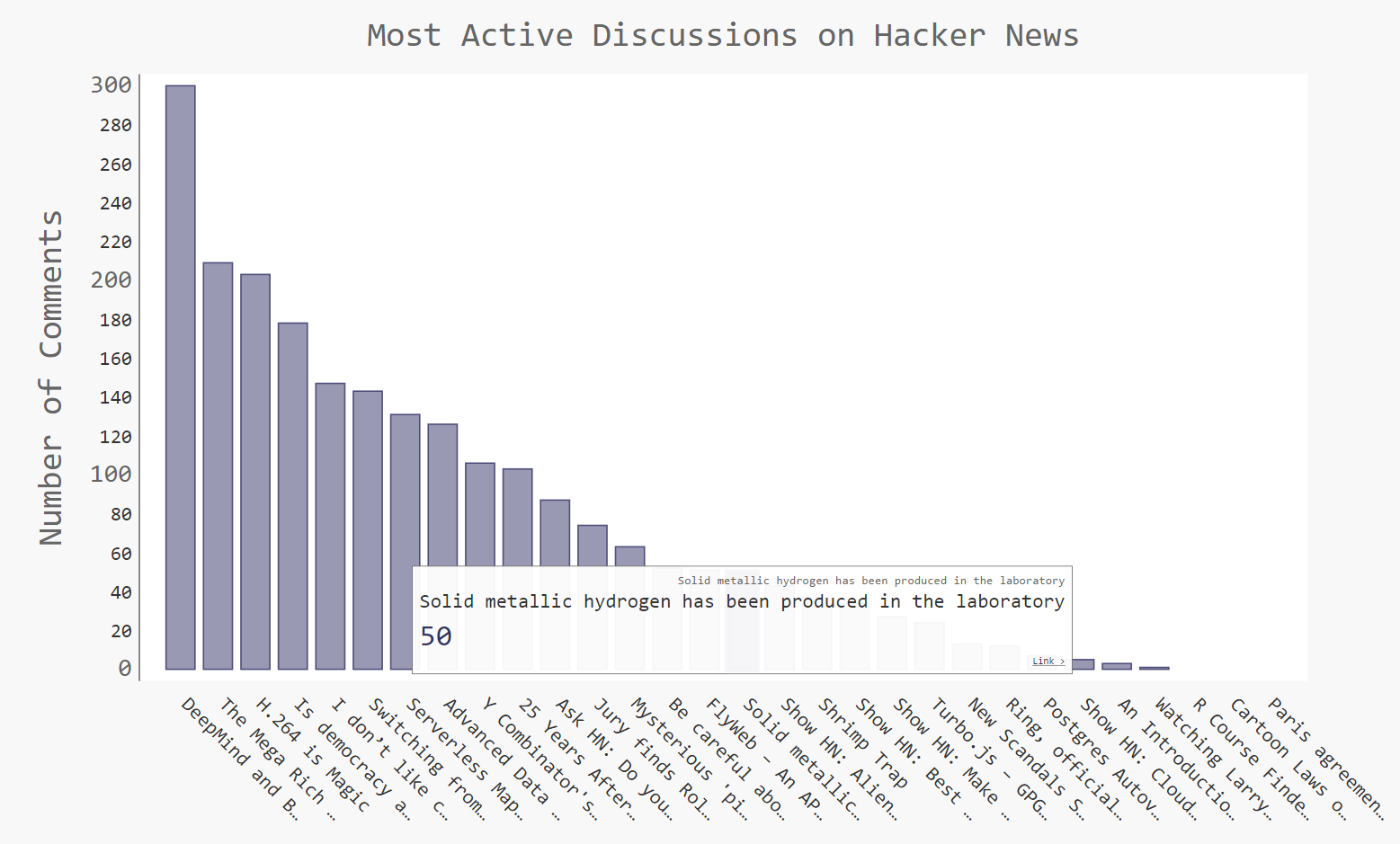Resources for the second edition are here. I'd love to know what you think about Python Crash Course; please consider taking a brief survey. If you'd like to know when additional resources are available, you can sign up for email notifications here.
Solutions - Chapter 17
Back to solutions.
17-1: Other Languages
Modify the API call in python_repos.py so it generates a chart showing the most popular projects in other languages. Try languages such as JavaScript, Ruby, C, Java, Perl, Haskell, and Go.
Note: The code for this exercise includes an update that keeps a project with an empty description from breaking the program, and moves the font size settings to my_style.
import requests
import pygal
from pygal.style import LightColorizedStyle as LCS, LightenStyle as LS
# Make an API call, and store the response.
url = 'https://api.github.com/search/repositories?q=language:javascript&sort=stars'
r = requests.get(url)
print("Status code:", r.status_code)
# Store API response in a variable.
response_dict = r.json()
print("Total repositories:", response_dict['total_count'])
# Explore information about the repositories.
repo_dicts = response_dict['items']
names, plot_dicts = [], []
for repo_dict in repo_dicts:
names.append(repo_dict['name'])
# When a project is removed, it's still listed with stars.
# So it's in the top projects, but has no description. The description
# is None, which causes an exception when being used as a label.
if repo_dict['description']:
desc = repo_dict['description']
else:
desc = 'No description provided.'
plot_dict = {
'value': repo_dict['stargazers_count'],
'label': desc,
'xlink': repo_dict['html_url'],
}
plot_dicts.append(plot_dict)
# Make visualization.
my_style = LS('#333366', base_style=LCS)
my_style.title_font_size = 24
my_style.label_font_size = 14
my_style.major_label_font_size = 18
my_config = pygal.Config()
my_config.x_label_rotation = 45
my_config.show_legend = False
my_config.truncate_label = 15
my_config.show_y_guides = False
my_config.width = 1000
chart = pygal.Bar(my_config, style=my_style)
chart.title = 'Most-Starred JavaScript Projects on GitHub'
chart.x_labels = names
chart.add('', plot_dicts)
chart.render_to_file('js_repos.svg')
Output:

17-2: Active Discussions
Using the data from hn_submissions.py, make a bar chart showing the most active discussions currently happening on Hacker News. The height of each bar should correspond to the number of comments each submission has. The label for each bar should include the submission’s title, and each bar should act as a link to the discussion page for that submission.
import requests
import pygal
from pygal.style import LightColorizedStyle as LCS, LightenStyle as LS
from operator import itemgetter
# Make an API call, and store the response.
url = 'https://hacker-news.firebaseio.com/v0/topstories.json'
r = requests.get(url)
print("Status code:", r.status_code)
# Process information about each submission.
submission_ids = r.json()
submission_dicts = []
for submission_id in submission_ids[:30]:
# Make a separate API call for each submission.
url = ('https://hacker-news.firebaseio.com/v0/item/' +
str(submission_id) + '.json')
submission_r = requests.get(url)
print(submission_r.status_code)
response_dict = submission_r.json()
submission_dict = {
'title': response_dict['title'],
'link': 'http://news.ycombinator.com/item?id=' + str(submission_id),
'comments': response_dict.get('descendants', 0)
}
submission_dicts.append(submission_dict)
submission_dicts = sorted(submission_dicts, key=itemgetter('comments'),
reverse=True)
for submission_dict in submission_dicts:
print("\nTitle:", submission_dict['title'])
print("Discussion link:", submission_dict['link'])
print("Comments:", submission_dict['comments'])
titles, plot_dicts = [], []
for submission_dict in submission_dicts:
titles.append(submission_dict['title'])
plot_dict = {
'value': submission_dict['comments'],
'label': submission_dict['title'],
'xlink': submission_dict['link'],
}
plot_dicts.append(plot_dict)
# Make visualization.
my_style = LS('#333366', base_style=LCS)
my_style.title_font_size = 24
my_style.label_font_size = 14
my_style.major_label_font_size = 18
my_config = pygal.Config()
my_config.x_label_rotation = 45
my_config.show_legend = False
my_config.truncate_label = 15
my_config.show_y_guides = False
my_config.width = 1000
my_config.y_title = 'Number of Comments'
chart = pygal.Bar(my_config, style=my_style)
chart.title = 'Most Active Discussions on Hacker News'
chart.x_labels = titles
chart.add('', plot_dicts)
chart.render_to_file('hn_discussions.svg')
Output:

17-3: Testing python_repos.py
In python_repos.py, we printed the value of status_code to make sure the API call was successful. Write a program called test_python_repos.py, which uses unittest to assert that the value of status_code is 200. Figure out some other assertions you can make - for example, that the number of items returned is expected and that the total number of repositories is greater than a certain amount.
Note: The code for this exercise includes an update that keeps a project with an empty description from breaking the program, and moves the font size settings to my_style.
Writing tests pushes you to structure your code in a way that it can be tested. Here’s a revised version of python_repos.py, with all of the work written as four functions:
import requests
import pygal
from pygal.style import LightColorizedStyle as LCS, LightenStyle as LS
def get_response():
"""Make an api call, and return the response."""
url = 'https://api.github.com/search/repositories?q=language:python&sort=stars'
r = requests.get(url)
return r
def get_repo_dicts(response):
"""Return a set of dicts representing the most popular repositories."""
response_dict = r.json()
repo_dicts = response_dict['items']
return repo_dicts
def get_names_plot_dicts(repo_dicts):
"""Process the set of repository dicts, and pull out data for plotting."""
names, plot_dicts = [], []
for repo_dict in repo_dicts:
names.append(repo_dict['name'])
# Some projects lack a description, which causes an error when
# labeling bars. Specify a label if there's no description.
description = repo_dict['description']
if not description:
description = "No description provided."
plot_dict = {
'value': repo_dict['stargazers_count'],
'label': description,
'xlink': repo_dict['html_url'],
}
plot_dicts.append(plot_dict)
return names, plot_dicts
def make_visualization(names, plot_dicts):
"""Make visualization of most popular repositories."""
my_style = LS('#333366', base_style=LCS)
my_style.title_font_size = 24
my_style.label_font_size = 14
my_style.major_label_font_size = 18
my_config = pygal.Config()
my_config.x_label_rotation = 45
my_config.show_legend = False
my_config.truncate_label = 15
my_config.show_y_guides = False
my_config.width = 1000
chart = pygal.Bar(my_config, style=my_style)
chart.title = 'Most-Starred Python Projects on GitHub'
chart.x_labels = names
chart.add('', plot_dicts)
chart.render_to_file('python_repos.svg')
r = get_response()
repo_dicts = get_repo_dicts(r)
names, plot_dicts = get_names_plot_dicts(repo_dicts)
make_visualization(names, plot_dicts)
Now we can write tests for these functions. Here we test that we get a response with a status code of 200, and we test that some of the keys we expect to find in each repository’s dictionary are in the first project’s dictionary.
import unittest
import python_repos_for_testing as pr
class PythonReposTestCase(unittest.TestCase):
"""Tests for python_repos.py."""
def setUp(self):
"""Call all the functions here, and test elements separately."""
self.r = pr.get_response()
self.repo_dicts = pr.get_repo_dicts(self.r)
self.repo_dict = self.repo_dicts[0]
self.names, self.plot_dicts = pr.get_names_plot_dicts(self.repo_dicts)
def test_get_response(self):
"""Test that we get a valid response."""
self.assertEqual(self.r.status_code, 200)
def test_repo_dicts(self):
"""Test that we're getting the data we think we are."""
# We should get dicts for 30 repositories.
self.assertEqual(len(self.repo_dicts), 30)
# Repositories should have required keys.
required_keys = ['name', 'owner', 'stargazers_count', 'html_url']
for key in required_keys:
self.assertTrue(key in self.repo_dict.keys())
unittest.main()
Output:
..
----------------------------------------------------------------------
Ran 2 tests in 1.969s
OK